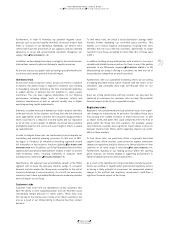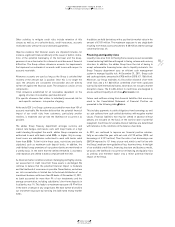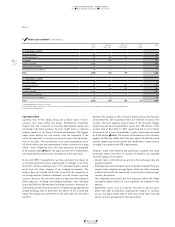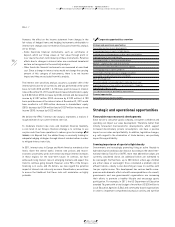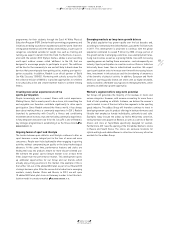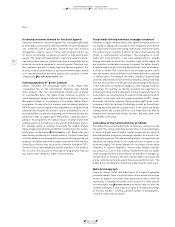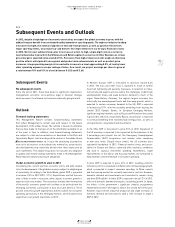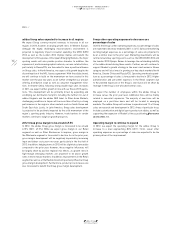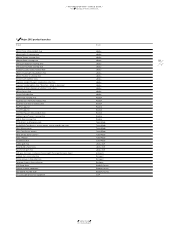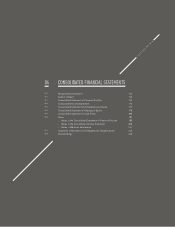Reebok 2011 Annual Report Download - page 165
Download and view the complete annual report
Please find page 165 of the 2011 Reebok annual report below. You can navigate through the pages in the report by either clicking on the pages listed below, or by using the keyword search tool below to find specific information within the annual report.
adidas Group
2011 Annual Report
GROUP MANAGEMENT REPORT – FINANCIAL REVIEW
161
2011
03.4 Risk and Opportunity Report Strategic and operational opportunities
Personalised and customised products replacing
mass wear
Today’s consumers are looking for choice and variety that go beyond
choosing from a wide selection of products. We engage in developing
unique and relevant products that fit specific functional and aesthetic
requirements
SEE GROUP STRATEGY, P. 60
. For example, the adidas, Reebok
and TaylorMade brands all offer different personalisation and custom-
isation platforms reflecting each brand’s strategy. Key concepts
at adidas include mi adidas, miTeam and miCoach. For example,
miCoach is a personalised training concept that combines product
technologies with an intelligent web platform. It offers a personal
and real-time audible coaching system, enabling the consumer to
collect and visualise real-life performance data. In 2011, adidas
launched both the miCoach Football app as well as the miCoach
Running app and thus reached a new milestone in personalisation.
With mi adidas and “Your Reebok”, consumers can already design and
order completely customised adidas and Reebok footwear online and
therefore create their own unique style. At TaylorMade-adidas Golf,
the myTPball online platform offers customers the opportunity to
create and order their own golf balls. In addition, TaylorMade-adidas
Golf’s Centres of Excellence provide customised fitting sessions for
golfers with expert fitters and technicians. We expect the market for
personalised and customised footwear, apparel and hardware to grow
strongly and evolve further in the coming years and we will therefore
continue to invest in the space.
Exploiting potential of new and fast-growing
sports categories
Exploiting the potential of emerging, fast-growing sports categories is
another opportunity for our brands. Our brand teams conduct market
research and engage in trend marketing to detect changes in lifestyle
and consumer needs of our target audience as early as possible.
Changes in lifestyle, habits and attitudes can potentially result in the
emergence of new consumer needs that are not addressed by current
market product offerings. For example, we see a growing trend in the
move by athletes and sports enthusiasts towards more minimalistic
products that promote natural body movement. In order to tap into
this opportunity, we are expanding our efforts to bring to market more
lightweight and flexible products that support the athlete’s natural
course of motion. In April 2011, Reebok launched RealFlex, a running
and training shoe designed to promote natural movement. Also in 2011,
adidas unveiled its first barefoot training shoe designed specifically for
the gym, the adipure Trainer
SEE ADIDAS STRATEGY, P. 72
. Promoting pure
and natural movement by harnessing the body’s natural mechanics,
the adipure Trainer activates and strengthens muscles, builds balance
and promotes dexterity. Similarly, we see tremendous growth potential
in the outdoor and action sport categories and intend to become a
leading player in those categories over the next years. Complementing
this ambition, in November 2011, the adidas Group acquired Five Ten,
a leading brand in the technical outdoor market, which enjoys high
credibility within the outdoor action sport community.
Expanding distribution scope
The sporting goods retail environment is changing constantly. People
increasingly want to get involved with our brands. We therefore
continue to adapt our distribution strategy to cater for this change
and have made controlled space initiatives a strategic priority. This
includes retail space management with key retail partners as well
as the introduction of new own-retail store formats. For example, in
December 2011, adidas celebrated the opening of its first Style Centre
in Beijing. The 400m² store is the first one globally to house the three
sub-brands SLVR, Y-3 and Porsche Design Sport under one roof. The
three labels have individual retail environments representing their
unique identities. Throughout the year, we continued to roll out new
shop-in-shop concepts globally and also further invested in unique
point-of-sale activation. In February 2011, for example, all 680 Finish
Line stores in the USA were outfitted with ZigTech imagery. Through
initiatives like these, we believe we will be able to target our consumers
more effectively, involve them emotionally with our products and,
therefore, ultimately drive sell-through at our retail partners.
Cost optimisation drives profitability improvements
Continued optimisation of key business processes and strict cost
control are vital to achieving high profitability and return on invested
capital. We are confident that there is still significant opportunity to
further streamline cost structures throughout our Group. In order to
achieve our Route 2015 targets, we are working on various efficiency
projects to minimise costs and drive operational performance. For
example, we continuously search for ways to increase efficiency in
our supply chain and make it truly demand-driven. Furthermore,
by implementing end-to-end planning processes and improving our
replenishment capabilities, we see opportunities to not only better
serve our customers but also to reduce our operating working capital
needs
SEE GLOBAL OPERATIONS, P. 90
. Another example in this respect is
the reduction of the number of articles; this reduces workload in
the creation area and warehouse costs, and allows us to offer more
focused ranges to our retail partners.


